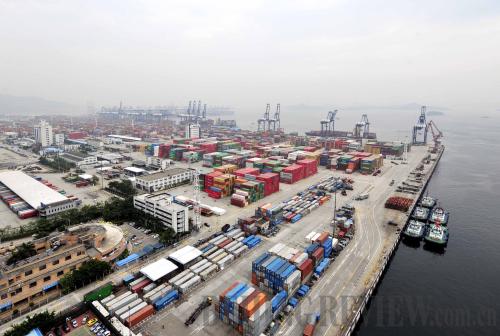|
 |
|
ROBUST TRADE: A container terminal in Yantian Port in Shenzhen, a special economic zone in south China's Guangdong Province (XINHUA) |
As the Communist Party of China (CPC) is to convene its 18th national congress later this year, it is yet again time for the Party to reflect on China's development thus far and find out where the country is going.
Since the 16th CPC National Congress in 2002, the CPC Central Committee has stuck to the implementation of the Scientific Outlook on Development, a socio-economic ideology initiated by President Hu Jintao, also General Secretary of the CPC Central Committee.
The ideology puts people first and calls for comprehensive, balanced and sustainable development instead of a blind pursuit of GDP growth. It attaches greater importance to raising quality and efficiency to achieve sound and rapid economic development. It emphasizes resources conservation and environmental protection and stresses that "development is for the people, by the people and with the people sharing in its fruits."
But after more than 50 years of strenuous effort, the CPC blazed a trail of socialist development with Chinese characteristics. In 2002, China's per-capita GDP approached $1,000, up from merely $27 in 1949, when New China was founded.
Although this benchmark brought new opportunities for the country's economic development, Chinese scholars warn that China should be cautious to avoid falling into the "middle-income trap."
The concept coined by the World Bank means that the strategies that allow countries to grow from low income to middle income are not enough to get them to high income. Historically, few countries have mastered the complex technical, social and political challenges that endeavor entails, according to the World Bank. During their drives to join advanced industrialized nations, countries like Brazil are said to be experiencing "growth without development."
"In this context, the Party leadership put forward the Scientific Outlook on Development, which answers the essential question of what kind of development is needed under new circumstances," Zhang Hefu, a senior research fellow with the CPC Central Committee Party Literature Research Office, told Oriental Outlook magazine.
"Growth, mainly referring to the increase of a country's GDP, is the basis of development. However, the sole pursuit of a bigger economy and more wealth without upgrading the economy and properly distributing wealth means that the growth will not be sustainable," said Li Junru, former Vice President of the Party School of the CPC Central Committee.
Hu first spoke of the Scientific Outlook on Development while visiting east China's Jiangxi Province in late August and early September of 2003.
In October 2003, the Third Plenum of the 16th CPC Central Committee endorsed Hu's initiatives, saying that the implementation would be of "great significance" for the country's further development.
In October 2007, the 17th CPC National Congress comprehensively explained the Scientific Outlook on Development and wrote it into the Party Constitution.
This conception targets such problems as unilaterally going after the pace of economic growth while ignoring the conservation of resources and the protection of environment, a worsening imbalance in urban-rural socio-economic development, growing income disparity and a rising frequency of accidents concerning occupational safety.
On November 13, 2005, workers' negligence and disregard of safety protocols in a chemical plant's processing tower caused explosions in northeast China's Jilin Province, killing eight people and injuring 60.
Due to the plant's lack of planning for an emergency situation like this, the explosions caused the spill of a large amount of toxic benzene into the Songhua River, forcing Harbin, capital of neighboring Heilongjiang Province, to cut water supplies to 3.8 million residents for four days, something never before experienced by a major city. As a result, China's top environmental official Xie Zhenhua resigned.
In May 2007, the government of Xiamen, a port city in southeastern Fujian Province, suspended the construction of a highly polluting chemical project after it drew heavy criticism from the public.
The planned site for the plant to produce carcinogenic paraxylene, a highly polluting petrochemical, was less than 1,500 meters from residential areas. Following persistent public protests, the city government solicited residents' suggestions from various channels through hearings and discussions participated by resident representatives. This plant was eventually relocated to a less densely populated area.
China's economic vitality has attracted the world's attention and claimed its title as a major engine for global growth.
| 